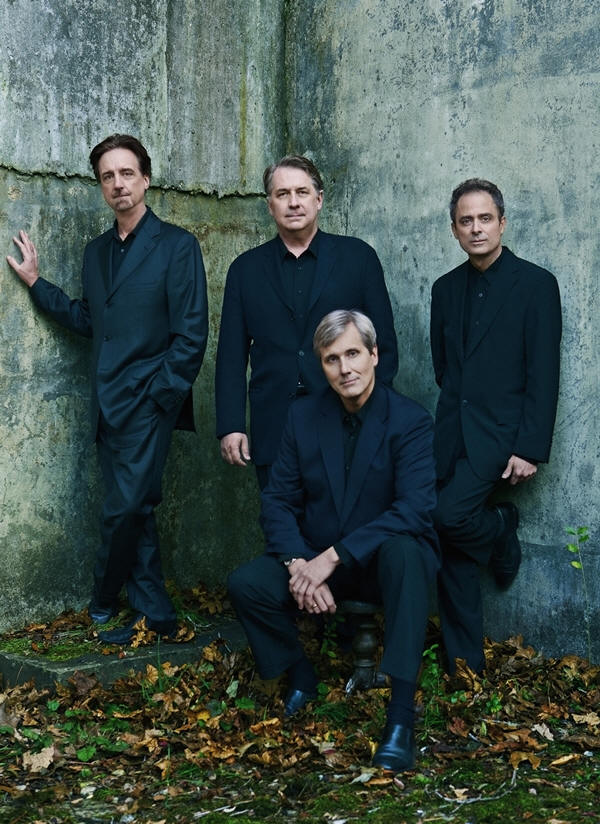Emerson Quartet brings a touch of class to Romantic program

The Emerson Quartet performed Sunday afternoon at Jordan Hall.
During a musical era often marked by iconoclasm and excess, Antonín Dvořák, Robert Schumann, and Johannes Brahms aspired to be numbered among the classical masters, right there with Haydn and Mozart. On Sunday afternoon in a Celebrity Series of Boston concert in New England Conservatory’s Jordan Hall, the Emerson String Quartet performed quartets by those three composers in a manner that, for restraint and sense of proportion, was as “classical” as they could ever have wished.
Except for cellist David Finckel—whose appearances with the quartet this season constitute a farewell tour before his announced retirement from the group next May—the musicians played standing up rather than seated as is their custom, and there was a straightforward, stand-and-deliver quality to the performance as well.
In fact, one might have wished for a little less poise and discipline in the first work on the program, Dvořák’s Quartet No. 9 in D minor, Op. 34. Granted, Dvořák wrote a serious work in a famously serious key (think “Death and the Maiden”), a piece he dared to send to Brahms for comment. (Brahms gave him a lecture on proofreading one’s music before sending it out.) But Dvořák’s musical personality is still the most genial and unbuttoned of these three composers, and it deserved something warmer than the rather pinched sound of this performance, heavy on the cello and thin on top.
Interpretatively, the ensemble kept a low profile through a smoothly-flowing first movement, a pallid polka, and an Adagio that was more matter-of-fact than ecstatic. (By this time, one really wanted to reach for the volume knob on that cello.) But the finale, with its marked 6/8 rhythm, seemed to boost the energy level, and the group played with fire and individuality right into the satisfyingly hot coda.
It was a coincidence no doubt, but after first violinist Eugene Drucker exchanged chairs—um, positions—with Philip Setzer for the last two works, the quartet found tonal balance and a sound well matched to each composer.
There was Schumann in his Quartet in A major, Op. 41, No. 3, right in character–poetic, a little flighty, tending to brood in the instruments’ lower registers, phrasing in surges and swoons, yet also proudly showing off his newly-won skill in counterpoint. His nervous, agitated side was soft-pedaled a bit at the start of the second movement, Assai agitato, but the ensemble brought out the character of the variations that followed, and the Adagio molto sounded as lush, songful, and rich in dialogue as one could wish for.
Again, an incisive theme made for a captivating finale, as the quartet vividly characterized the main tune and the contrasting episodes, in a performance that came across the footlights even at the softest dynamic level.
The usual explanation for Brahms’s taking so long to publish a string quartet is that he feared comparisons with Beethoven. But hearing the Emerson play his Quartet in A minor, Op. 51, No. 2, one marveled that Brahms ever found a way to be Brahms using just four instruments, none of which was a piano.
Yet there he was, too, sonically in a darkened room where the sound of men’s voices (in the viola and the second violin’s low G string) predominated, and the mood was somber and agitated. Refusing to exaggerate any detail for effect, the quartet made the first movement’s restless, changeable music seem to grow organically.
Moving the Andante moderato along with a steady pulse, the quartet reminded listeners that Brahms considered andante (literally “going”) to be one of the fast tempos. Their performance was beautifully voiced in the outer sections, with the first violin at last singing out a bit, and the violin-cello canon in the middle was smartly done.
The third movement was a minuet with a twist—lots of twists, in fact, which the quartet skillfully negotiated without losing sight of the long phrase line. More twists followed in the finale, with its constant shifts of rhythm and surprising harmonies that are hard to play in tune; the Emerson managed it all with assurance, with each player (but especially violist Lawrence Dutton) shining when the spotlight was turned on him.
A bizarre event concluded the concert. Called back to the stage twice following the Brahms, the quartet offered an encore, announced by Setzer as the fourth of Webern’s Five Pieces for String Quartet, Op. 5. Although the piece was only 13 measures long and was an “unusual” choice for an encore, Setzer said, it was “what the other pieces were leading to” and “a distillation of Romanticism.”
As the players lifted their bows, a woman in the balcony cried out, apparently in distress. Audience and performers froze in place as ushers and a doctor rushed to the woman’s aid. After a minute or so, a man’s voice from the balcony said “Go ahead,” and the quartet played Webern’s extremely soft and attenuated music, to the sound of muttering voices upstairs.
As the audience filed out, ushers cleared a path to waiting fire and EMS vehicles, but no emergency evacuation took place. About 15 minutes later, a woman who appeared to be calm and in stable condition was slowly wheeled out of the building and taken away in an ambulance.
The next concert in the Celebrity Series of Boston will be pianist Paul Lewis performing sonatas by Schubert at Jordan Hall, Saturday, January 12. celebrityseries.org. (617) 482-6661.
Posted in Performances




